by Gerard Huissen
My first meeting with Ostia-Antica
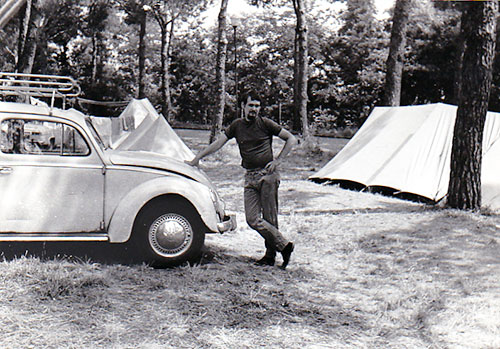
In 1967 I travelled with my present wife to Rome for our engagement. Her brother and his friend accompanied us. For me, it was my second visit to Rome and we stayed, like my first visit, at a no longer existing camping place on the Monte Antenne, a hill near the Via Salaria. Rome was hot that year and at the camping place there was no swimming pool. I could imagine why in the old times bathhouses were so popular. My future brother-in-law and his friend had noticed that there was a beach not so far away where they maybe could find some refreshment. One day, my fiancé and I drove to what I later knew to be Ostia Lido. Driving our white Beetle over the Via Ostiense towards the coast at our right, I saw a ruin. Not an ordinary ruin, but a very large one surrounded by a fence to which no end seemed to come. My fiancé and I decided to investigate that spot after we had left our companions on the black beach of Ostia Lido. Arriving at Ostia-Antica, we visited an excavation like we had never seen before, although we had not the slightest idea what we were looking at. In those days there were no signs. I could not know at that moment how important this first visit to Ostia would be for a big part of my life. In the bookshop, located in a big cave next to the entrance of the theatre, I bought a couple of small books about Ostia. Two days later we left for Ventimiglia, on the north coast of Italy, to enjoy the beach for another week. Rome, in the summer, without a swimming pool can be deadly. It would take a couple of years before I visited Ostia again. At home I started reading about Ostia and the more I read about the old city, the more excited I became. Meanwhile, I had started a career as filmmaker and photographer and decided to make my first photo report in Ostia.
Alberino Vicari
In August 1975, I left Amsterdam to stay for a week in Rome accompanied by two friends, future artists. One of them was the son of a medical doctor from Zeeland. As a child, his family had spent their holidays in Italy, so his Italian was pretty good compared to mine. At that time I didn’t speak any Italian. In Rome, we stayed again at the same camping place and we drove every day to Ostia. The first day, when we arrived at the gate, we were sent back to Rome immediately to obtain a ‘permesso,’ which was in those days still very easy. After an hour and a half, we returned to Ostia with a license to take pictures professionally, thanks the translating ability of my friend. The latter left to make watercolor paintings outside Ostia and I started my work at the excavation.
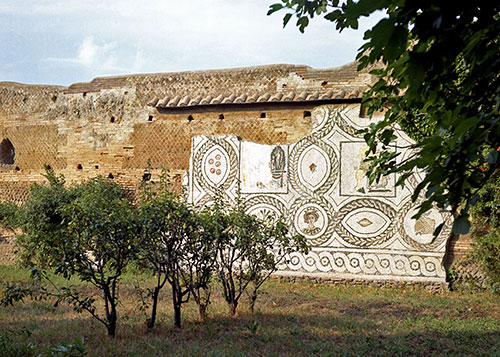
On the third day I entered a large garden of one of the houses in Ostia. In the garden was a beautiful mosaic attached to a wall(1). Behind me I heard a noise and saw a man working in one of the chambers of the building. I saluted him and he answered in English. We started a conversation. The man, middle aged, had ruddy skin, blonde hair and wore a white dustcoat. An atypical Italian. I had met Alberino Vicari.
Alberino, still speaking passable English, which he later seemed to have forgotten, told me that he had learned English during his war time captivity in England. So we were able to communicate and I was curious about him and what he was doing in Ostia. Then he told me the remarkable story about the start of his career at the excavation of Ostia Antica.
Alberino, living on the outskirts of the modern Ostia-Antica, was still a boy of 14 years when, in 1938, the great excavation campaign under supervision of the Italian archeologist Guido Calza started. This campaign was initiated by Mussolini to serve as a showpiece for the world exhibition planned in Rome for 1942. A part of Ostia, east of the forum, was already excavated. Calza concentrated mostly on the western part, from the forum towards the sea. During the excavation of the so-called Terme dei Sette Sapienti, the bathhouse of the seven philosophers(2), an underground tunnel was found. To determine the dating of the building, they needed a tiny person to enter the small corridor and to look after marked stones. Calza suggested asking his gardener, a rather small man. When they arrived at the house of the gardener, they learned from his wife, Mrs. Vicari, that her husband had died two days ago. But, living without income and no assurance, she offered her tiny son to do the job. Calza agreed and Alberino officially became part of the ‘great excavation’ under the protection of professor Guido Calza. Later, Calza gave him the opportunity to study at the Academia Belle Arti in Perugia. His specialty was to prepare and preserve the old paintings of Ostia, Portus and Isola Sacra. Until his retirement, he fulfilled this profession with varying degrees of success.
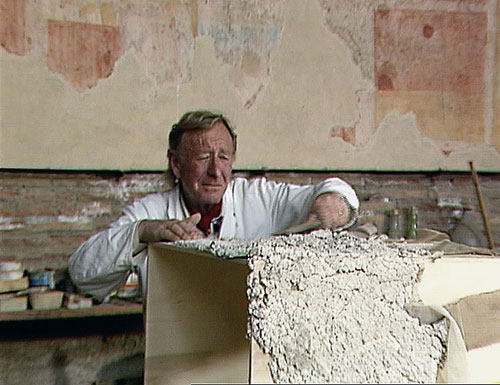
His atelier in the Casa di Bacco Fanciullo was located in, as Alberino called it, the most beautiful room in Ostia. Every time I visited Ostia, from 1975 on almost every year, I met him in his atelier. When he saw me, he stopped working immediately, took off his working clothes and walked with me to the theatre, where a coffee shop was located next to the bookshop in those days. There I heard all the gossip about Ostia. After the coffee we went to the executive office, which was then next to the museum, where he picked up a bunch of keys to show me all the locked places of Ostia.
The Story Teller
At our first meeting, I told Alberino that my limited knowledge of Ostia came from the small books bought at Ostia’s bookshop. He drew my attention to an important book written by a British Oxford professor, the historian and connoisseur of Ostia, Russell Meiggs, called ‘Roman Ostia’(3). Meiggs, who had visited Ostia for the first time in 1925, was also working in Ostia during the campaign of 1938 and became friends with Alberino around 1940. I bought the book, read it with great interest and from that time on, Ostia was for me, a completely different city. According to Alberino, Meiggs was a flamboyant man, particularly for that time, with long hair, bushy eyebrows and a knitted sweater made by his wife with a picture of the lighthouse of Claudius on it. When I met Mr. Meiggs in Oxford a couple of years later, his description seemed to be right. The Meiggs’ book showed me how important the campaign of 1938-42 was for the overall view of modern Ostia. If you walk over the excavation you still will find the serenity of a beautiful landscaped park. Guido Calza’s wife, Raisa Calza-Gurevič was responsible for the construction. She planted only trees and bushes well known in ancient Roman times.
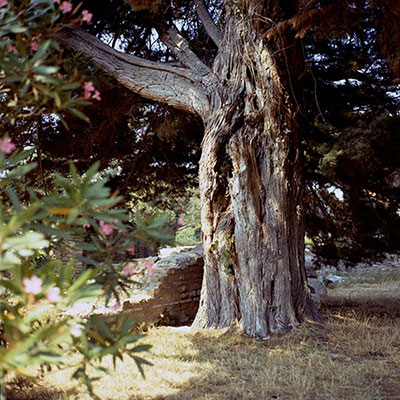
Alberino told this story to a group of American tourists at the Piazzale delle Vittoria(4). A place, as connoisseurs of Ostia know, with a very old tree. Certainly old but not as old as one of the tourists had understood: “Look,” she said, “a tree planted by the ancient Romans”.
Alberino knew much about Ostia. Very much. He knew where and when every statue was excavated and in what condition, which other objects were found during the past years and so on. He knew everybody. It seemed to me that he was always on the spot when something important happened. But I could not imagine that professor Calza was always calling a 15-year old boy when something was found. When I asked him he told me that his passion for Ostia was so strong that he helped the workers at night by bringing the newly discovered objects to the warehouses, while besetting his colleagues with questions. He identified himself with Ostia, saw it as his actual home and had no intention to leave this excavation ever. While saying this, he looked on his watch and apologized with the words: “But now I have to go home for lunch”. Then he took the bus and went to Ostia Lido where he lived with his wife and son in a modern apartment. He was still more Italian than I thought. The Soprintendenza noticed Alberino’s vast knowledge of Ostia, too. Therefore, he was asked frequently to guide famous people like heads of state, actors, etc.
There was for example the widow of President Roosevelt, Eleanor Roosevelt, who visited Ostia once. Alberino, dressed in his best suit, was waiting for the guests with great anticipation. The expectation became even bigger when they arrived and he saw that Mrs. Roosevelt held a packet under her arm. Maybe a little present for the guide, he thought. He started his tour and after a while they arrived at the Casa di Diana(5). Mrs. Roosevelt asked the group to stay outside the building.
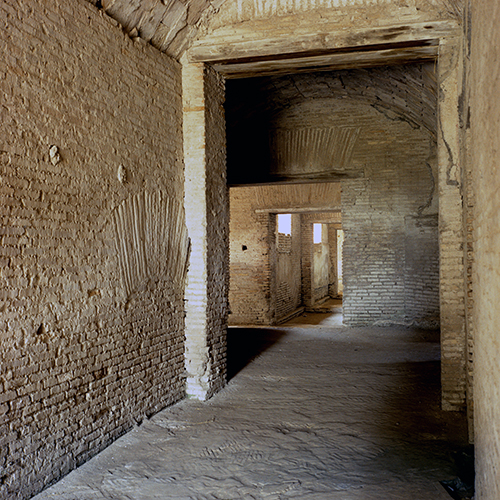
Only Alberino was allowed to accompany her into house. But entering the first room, he also had to wait. She walked to another room alone. After a couple of minutes she returned, dressed like an ancient Roman lady and said: “From my childhood on, I wished to walk once like a Roman lady in an old Roman setting.” Alberino guided her through the building, and after a while she went back to her ‘dressing room’, changed her clothes again and walked out of the building. Also Alberino joined the company again but now with less high hopes about the package. It seemed not to be a present for the guide. He was not supposed to tell me this story, but Mrs. Roosevelt had died years ago and Alberino did not feel bound to his promise.
Alberino told full versions of one story after another, but not always scientifically correct ones. Like the story about the Casa dei Molini(6). In the mill, you can see some hoof prints in the floor of the entrance. Alberino explained these prints (according to him, not only animal prints but also human prints) as follows: Once upon a time there was a big volcanic eruption. Mice and men fled over the still soft lava, leaving their footprints. When the lava wasn’t liquid anymore it was cut into stones and brought to Ostia. A nice story, but not very likely. A more logical explanation is that the stone first were laid around the mills. Mules or horses turned these around and they walked the whole day in the same trail so that after a while their footprints were carved in the stones of the floor. When the carvings were too deep, the miller removed the stones and reused them in the entrance.
Another noteworthy story was his explanation of the Casa delle Volte Dipinte, the house with the painted ceilings(7). The house was well known as a guesthouse for the less fortunate visitors to ancient Rome. The building, with at least two floors, stands detached on all sides and has an outside bar. From old records, we know that you could also hire a girl for pleasure in this kind of place. Alberino had a more particular idea about the house. According to him, it was he biggest brothel in Ostia. It stood detached to protect the young daughters living in the surrounding houses against the dishonorable profession (maybe the walls were contagious in those days).
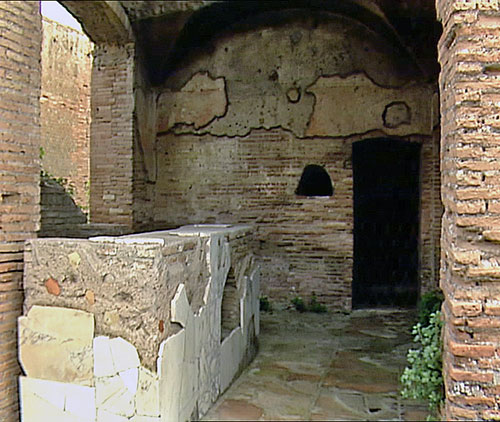
The bar had been located outside for practical reasons and had a small opening next to the entrance door. Through this opening, drinks and other things could be passed to the naked girls inside the building.
Long after his retirement, Alberino kept coming to the excavation. Most of the time he spent guiding tourists. I don’t know whether he was paid for this work or that he did it for pleasure only. I never asked. Although there was already a successor appointed, the room at the Casa di Bacco Fanciullo, where he had worked so long, remained ‘his atelier’. Even today, it is still there untouched. Once, he introduced me to his female successor. The lady, spending most of her time making homemade items for tourists, was clearly missing the passion of Alberino. To me, Alberino was not only a good friend, but above all, the only person in Ostia involved by the great excavation campaign of 1938; a man who deserved more than being just one of the guides in Ostia. So, in 1991, I decided to make a film about Ostia with Alberino in the lead role. During one of our meetings, Alberino told me that a Dutch archeology student from Leiden interviewed him that year. Back home, I contacted this student and asked him to be an advisor for my film. And so started my friendship with Jan Theo Bakker(8).
Ostia, the city behind the city
The idea of the film was to show that behind a city, in this case a seaside resort, there could be more than you would expect. The same happened to me 24 years earlier. The pre-production of the film brought me closer to Alberino. In earlier years, in going home for lunch, he made an excuse for not asking me to his home for lunch. He said he would like to invite me, but unfortunately during the summer his wife was always unwell. So if I should come here in winter… In Autumn 1991, I went to Rome again, accompanied by a colleague, and we were finally invited for lunch at his home in Ostia Lido. While I had always in mind that Mrs. Vicari was a small, black-dressed, sickly old woman, the opposite was true. In their modern apartment, I met a tall lady, dressed to the latest fashion and recently cut, short hair. Besides that, a lady not at a loss for words. In this environment, Alberino seemed to be a completely different man, who dared not argue with his wife and her son. This put the expression ‘actually, Ostia is my real home’ in a pretty different perspective. In Ostia, Alberino was the last living witness to the time of the great excavators. He had worked with all the big names, Calza, Gismondi, Bloch, and Meiggs, but he remained a simple man.
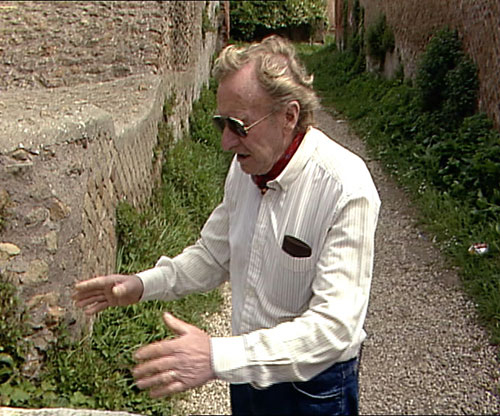
Alberino Vicari died two years after finishing the movie.
(Translation made by Robert G. Harp)
- Notes:
- (1) Casa di Bacco Fanciullo (I, IV,3)
- (2) Terme dei Sette Sapienti (III, X, 2)
- (3) ‘Roman Ostia, Russell Meiggs, Oxford at the Clarendon Press, 1973, ISBN 0 19 814810 0
- (4) Piazzale delle Vittoria (V, XVII,2)
- (5) Caseggiato di Diana (I,III,3-4)
- (6) Caseggiato dei Molini (I,III,1)
- (7) Casa delle Volte Dipinte (III, V, I)
- (8) Dr. Jan Theo Bakker is the owner of www.ostia-antica.org, a website where you can find almost everything about Ostia
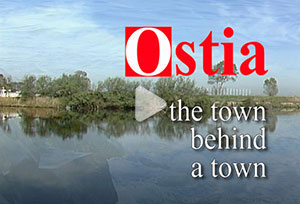






 We are committed to providing versions of our articles and interviews in several languages, but our first language is English.
We are committed to providing versions of our articles and interviews in several languages, but our first language is English.